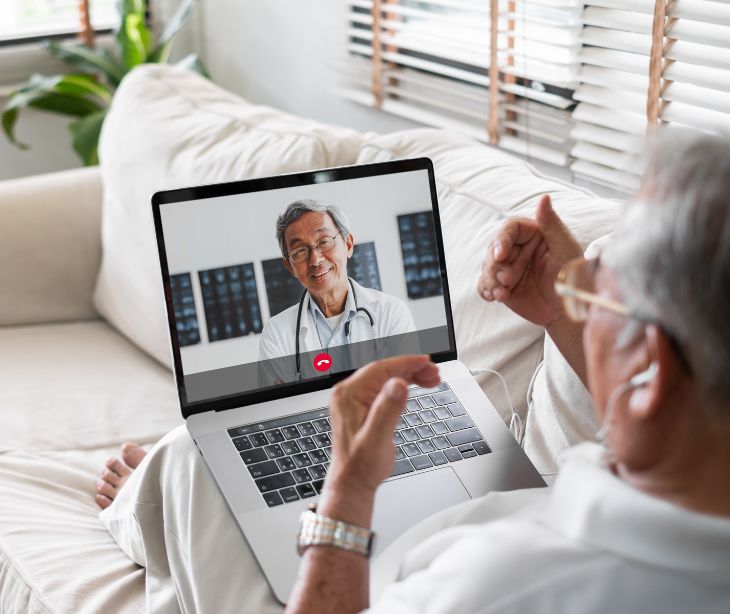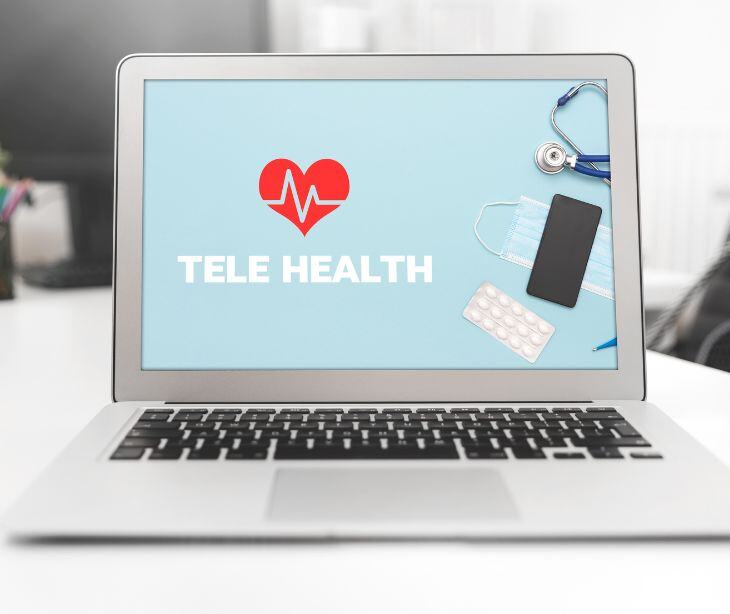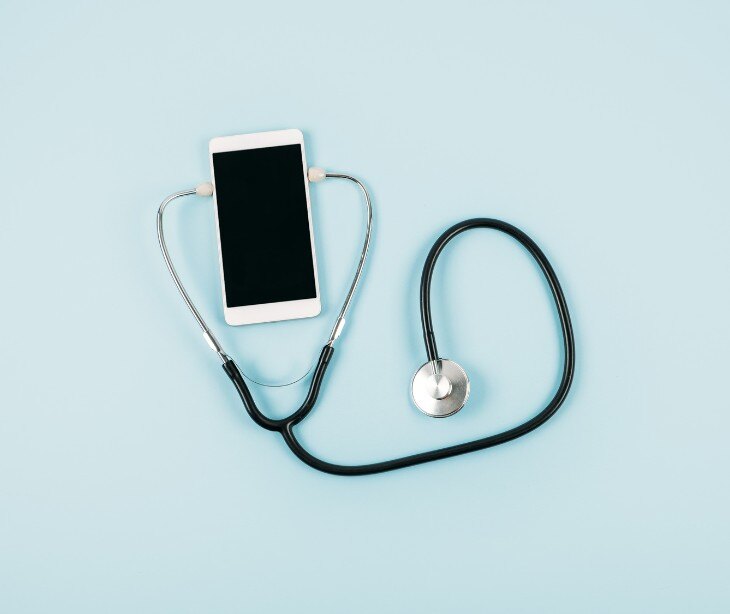
Telehealth is using telecommunications and digital technologies to deliver healthcare services remotely. It includes various services and applications, from remote consultations and diagnosis to monitoring and education.
Telehealth leverages various communication tools, such as video conferencing, mobile apps, secure messaging platforms, remote monitoring devices, and other forms of digital communication, to facilitate interactions between patients and healthcare providers. The goal of telehealth is to improve access to healthcare services, particularly for individuals who face barriers to in-person care, such as those living in rural or underserved areas, individuals with mobility issues, or those with limited access to transportation.
The rise of telehealth
Telehealth has revolutionized healthcare by enabling physicians to deliver long-distance medical services. However, telehealth is not a new phenomenon; doctors first diagnosed patients via radio in the 1920s.
During the COVID-19 pandemic, telehealth usage significantly increased, followed by stabilization. The spike in telehealth was seen around April 2020 during the initial outbreak of cases, where it constituted 69% of doctor-patient consultations. Telemedicine utilization has since drastically declined in the United States.
In the news
According to Forbes, “video conferencing is the most commonly used RTC technology in telehealth apps,” with the industry “projected to achieve a value of $559.52 billion by 2028.”
Telehealth offers benefits such as accessibility in rural areas, improved patient engagement, and reduced healthcare costs.
Benefits of video communication
- Remote consultations: Video communication allows patients to consult with healthcare providers remotely, eliminating the need for in-person visits. This is especially beneficial for patients who live in rural or remote areas with limited access to healthcare facilities.
- Increased access to specialists: Patients can connect with specialists located in different geographic locations without the need for travel. This expands access to specialized care for individuals who may not have easy access to certain types of healthcare providers locally.
- Convenience and flexibility: Video consultations offer convenience and flexibility for both patients and healthcare providers. Patients can schedule appointments at times that suit them without the need to take time off work or arrange transportation to a healthcare facility.
- Reduced healthcare costs: Telemedicine can help reduce healthcare costs by minimizing the need for in-person visits, transportation expenses, and time off work for patients. It can also lower costs for healthcare facilities by reducing the overhead associated with maintaining physical infrastructure.
- Remote monitoring and management: Video communication enables remote monitoring of patients with chronic conditions or those recovering from surgery. Healthcare providers can remotely monitor vital signs, provide guidance on medication management, and offer support to patients in their home environments.
- Emergency consultations: Video communication can be particularly valuable in emergencies where immediate access to medical advice is crucial.
- Continuity of care:Video communication simplifies communication between healthcare providers, ensuring coordinated care across different settings.
Challenges associated with video communication
While video communication offers numerous benefits in healthcare, it also presents several challenges that healthcare providers must address to ensure effective and secure implementation. Here are some of the key challenges associated with video communication:
- Technical issues: Technical glitches such as poor internet connectivity, audio/video lag, or software malfunctions can disrupt video communication sessions, leading to frustration for both patients and providers.
- Privacy and security concerns: Maintaining patient privacy and security during video communication sessions is paramount, especially when discussing sensitive medical information.
- Digital divide: Disparities in access to technology and digital literacy may limit certain patients' ability to participate in video communication. Individuals from underserved or rural areas, older adults, and those with limited technological proficiency may face barriers to accessing video communication services.
- Quality of care concerns: Some healthcare services, such as physical examinations or procedures requiring hands-on intervention, may be challenging to conduct effectively via video communication.
- Interoperability issues: Lack of interoperability between different video communication platforms and electronic health record (EHR) systems can hinder seamless communication and data exchange between healthcare providers.
- Regulatory and legal considerations: Healthcare providers must navigate complex regulatory and legal frameworks when implementing video communication services, including licensure requirements, reimbursement policies, liability issues, and compliance with healthcare regulations such as HIPAA.
- Patient engagement and adherence: Engaging patients and encouraging active participation in video communication sessions can be challenging, particularly for individuals who may feel uncomfortable or unfamiliar with the technology.
Addressing these challenges
Addressing the challenges associated with video communication requires a multifaceted approach that encompasses technological solutions, policy development, training and education, and collaboration among healthcare stakeholders. By proactively identifying and mitigating these challenges, healthcare providers can leverage video communication to enhance access, efficiency, and quality of care while promoting patient-centered healthcare delivery. Here's how these concerns can be addressed:
Technical solutions
- Invest in reliable technical infrastructure, including high-speed internet connections, quality cameras and microphones, and robust video communication platforms.
- Implement redundancy measures and backup systems to mitigate the impact of technical failures.
- Provide technical support and troubleshooting resources to assist patients and providers in resolving issues promptly.
Privacy and security measures
- Select HIPAA compliant video communication platforms that offer access controls, secure transmission protocols, and adherence to regulatory standards.
- Train healthcare providers on best practices for maintaining patient privacy and security during video consultations, including conducting sessions in private, secure locations.
- Implement policies and procedures for securely storing and disposing of video communication recordings containing PHI.
Digital inclusion and accessibility
- Address disparities in access to technology and digital literacy by providing resources and support to underserved populations, older adults, and individuals with limited technological proficiency.
- Offer alternative communication options, such as telephone consultations, instant messaging, HIPAA compliant emails and text messages, or in-person visits, for patients who face barriers to accessing video communication services.
Quality of care assurance
- Develop guidelines and protocols for determining the appropriateness of video communication for different types of consultations and medical scenarios.
- Provide training and resources to healthcare providers to ensure they can effectively conduct virtual examinations, assessments, and procedures when appropriate.
- Foster collaboration between telemedicine providers and in-person care teams to ensure continuity of care and facilitate referrals as needed.
Interoperability initiatives
- Advocate for standards and protocols that promote interoperability between video communication platforms and EHR systems.
- Participate in interoperability initiatives and collaborate with technology vendors to develop solutions that facilitate seamless communication and data exchange across platforms.
Regulatory compliance and legal considerations
- Stay informed about regulatory requirements, licensure policies, reimbursement guidelines, and liability issues related to video communication in healthcare.
- Develop and implement policies and procedures to ensure compliance with HIPAA regulations, patient consent requirements, and other legal obligations.
- Work closely with legal advisors and regulatory experts to navigate complex regulatory landscapes and mitigate legal risks associated with video communication.
Patient engagement and education
- Offer patient education and training on how to use video communication platforms effectively and securely.
- Provide clear instructions and guidance to patients on accessing video consultations, participating in sessions, and protecting their privacy.
- Solicit feedback from patients to identify barriers to engagement and adherence and make adjustments to improve the patient experience.
See also: Audio-only telehealth services and HIPAA compliance
Ensuring HIPAA compliance in video communication
Ensuring HIPAA compliance in video communication safeguards patient privacy and maintains the security of protected health information (PHI). The Health Insurance Portability and Accountability Act (HIPAA) sets forth strict standards for the privacy and security of PHI, and any video communication platform used in healthcare must adhere to these regulations. Here are some considerations for ensuring HIPAA compliance in video communication:
- Secure transmission: HIPAA requires that PHI be transmitted securely to prevent unauthorized access or interception. Video communication platforms used for telemedicine must employ encryption protocols (such as SSL or TLS) to encrypt data transmitted between users.
- Access controls: HIPAA mandates that access to PHI be restricted to authorized individuals only. Video communication platforms should implement robust access controls, including user authentication mechanisms (such as usernames and passwords) and role-based access control (RBAC).
- Data storage and retention: HIPAA regulates the storage and retention of PHI, requiring that healthcare organizations maintain adequate safeguards to protect PHI from unauthorized access or disclosure. Video communication platforms must provide secure storage mechanisms for storing recorded video consultations or any other PHI transmitted during the session. Additionally, platforms should have policies and procedures in place for securely deleting or disposing of PHI once it is no longer needed.
- Business associate agreements (BAAs): According to HIPAA rules, covered entities must enter into business associate agreements (BAAs) with any third-party service providers (such as video communication platforms) that have access to PHI.
- Audit trails and logging: HIPAA requires covered entities to maintain audit trails and logs of access to PHI, including video communication sessions. Video communication platforms should provide audit trail functionality that logs user activities, such as logins, access to PHI, and any modifications made to PHI.
- Training and awareness: Covered entities must train their workforce on HIPAA compliance policies and procedures. Healthcare providers must ensure that staff members who use video communication platforms receive training on how to use the platform securely and understand their responsibilities regarding the protection of PHI.
- Risk assessments and security measures: HIPAA mandates that covered entities conduct regular risk assessments to identify potential vulnerabilities in their systems and implement appropriate security measures to mitigate those risks.
The alternative: HIPAA compliant email
HIPAA compliant email is a viable alternative to video communication for healthcare providers seeking a secure means of exchanging PHI. While video communication platforms offer real-time interactions, email offers asynchronous communication, which may be more suitable for certain situations, such as sharing lab results, medical records, or appointment reminders. With robust encryption and access controls, HIPAA compliant email ensures the secure transmission of PHI, mitigating the risk of unauthorized access or disclosure. Additionally, email services like Paubox often provide features for secure message delivery and access monitoring, enabling healthcare organizations to track and audit email communications for compliance purposes. By leveraging HIPAA compliant email, healthcare providers can communicate while safeguarding patient privacy and adhering to HIPAA regulations.
Go deeper: HIPAA Compliant Email: The Definitive Guide
FAQs
Do healthcare providers need to obtain consent for video communication?
Yes, healthcare providers typically need to obtain consent from patients before conducting video communication sessions, especially if the sessions involve the exchange of PHI. Patient consent ensures that individuals understand the purpose, risks, and potential benefits of video communication and have the opportunity to make informed decisions about their participation.
Read more: Patient consent: What you need to know
What are some common use cases for HIPAA compliant email in healthcare?
Common use cases for HIPAA compliant email include sending lab results, medical records, appointment reminders, follow-up instructions, educational materials, and administrative documents securely between healthcare providers and patients.
What are the benefits of using HIPAA compliant email and video communication in conjunction?
Integrating HIPAA compliant email with video communication enables healthcare providers to communicate securely and comprehensively with patients and colleagues. It allows for the exchange of supplementary information, appointment reminders, follow-ups, documentation, patient education materials, and administrative tasks while maintaining compliance with HIPAA regulations.
Subscribe to Paubox Weekly
Every Friday we'll bring you the most important news from Paubox. Our aim is to make you smarter, faster.




